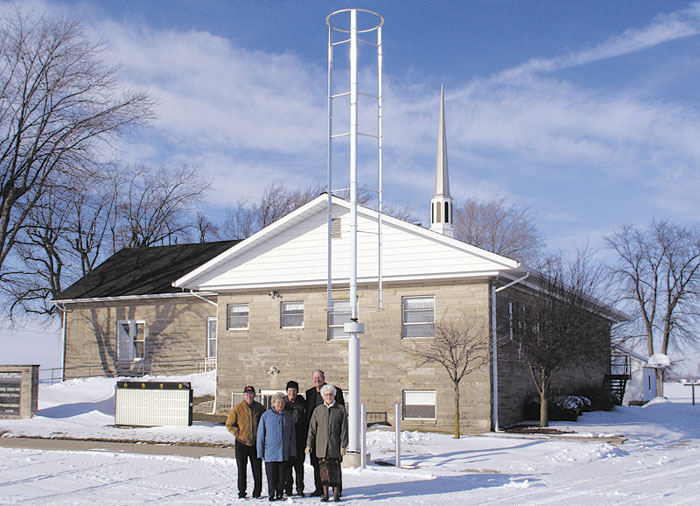Rural Converse church harnesses wind to generate electricity
Location:
5048 N 900 W 27 Converse, IN 46919-9380
Daniel R. Gangler (view original posting )
CONVERSE, Ind. – When the wind blows hard across the open spaces of central Indiana, roof shingles fly, backyard sheds blow into nearby fields and in the winter months, water pipes freeze and burst open.“We ought to make use of that wind,” thought George Kilmer. He’s a member of Richland Chapel United Methodist Church northeast of Converse, Ind., in the middle of the state where the land is flat and the wind blows constantly.
The dream of harnessing that wind to drive an electric-generating turbine at church came to Kilmer a couple of years ago. He heard his Nebraska in-laws talk about saving 60 percent on electric bills after they had built a 100-foot-high turbine on their farm. Kilmer said if a turbine was good enough for a farm, it would be good enough for his open-country church.
Dream fulfilled
His dream was fulfilled Dec. 12 when this open-country church turned on its recently installed 30-foot high and four-feet wide Windspire turbine generator. It has blades which look something like a giant kitchen-mixer beater. The manufacturer promises the 1200 watt unit will generate 2,000 kilowatt hours of electricity a year with only a 12 mile-per-hour wind. It’s almost virtually silent and the wind in central Indiana usually blows much faster than 12 mph. Kilmer was so excited about his find and the need of his church to have one, he gave the church $12,716 needed to purchase the turbine. Church members are grateful.
The Windspire is made by Mariah Power (www.mariahpower.com) of Reno, Nev., manufactured by MasTech Manufacturing in Manistee, Mich., and distributed in Indiana by Northwest Geothermal of DeMotte, Ind. It only took the church one month from the time it ordered the unit to the time it was delivered for installation. Standing in front of Richland Chapel’s newly acquired electrical-generator turbine are (left-to-right) Tom and Pauline Kratzer, George Kilmer, Earl Brown and Pastor Carolyn Mikesell.
Trustees did run into one snag on building the turbine – zoning. They wanted to erect the turbine on the property line, but were told by local officials that the church would need enough property so that the turbine would be on church property when taken down for repairs. That meant securing more land from Tom and Pauline Kratzer, their farm neighbor to the east. Fortunately, the Kratzers are members of the church and willingly gave the church the extra land.
According to Earl Brown, a leader of the congregation, the electric-generating turbine is only one part of the church’s efforts during the past couple of years to become more ecologically efficient than it had been. The move began when the air-conditioning unit quit working. The church replaced it with an energy efficient heat pump. Not only does it cool, it also heats a classroom and the back of the sanctuary. He said it paid for itself in two years with the amount of energy saved.
Trustees have already installed ceiling fans, added one more foot of insulation in the attic above the sanctuary and turn down the thermostat to 54 degrees when the building is unoccupied. Brown said the church is now in the process of replacing ordinary light bulbs with new compact fluorescent lights. With the advent of both the heat pump and the wind turbine, the church is using more electricity for heating only occupied spaces during the winter rather than heating the whole facility with an oil powered boiler.
Good stewardship
Carolyn Mikesell, pastor of Richland Chapel, is in tune with the changes, not just with saving-money but with a theological emphasis upon ecology as good stewards. During a recent interview at the church, she said, “We have to wake up… I feel a great need for us to take care of the earth in the way God intended for us to do. As a pastor, it is my responsibility to pass my (ecological) concerns on to the congregation about taking care of the earth. We are destroying what God has given to us to take care of.”
She added. “When you go to Europe you realize they don’t live like we do. They conserve things. They do without. They just live a plainer life. Over there you almost feel embarrassed that we waste so much.” She confessed that when she first mentioned using the old dishes instead of Styrofoam plates, her idea didn’t go over well. Members asked, “what does this mean?” She explained “what it means is that we are taking better care of the earth. Now I haven’t heard anybody complain about the conservation measures we have taken. They have accepted the fact that we are connected to the earth through God.”
Recycling and saving energy has become a part of life at Richland Chapel. The church recycles everything from paper to plastic and is fortunate to have two community recycling sites close to its building. The turbine is so new the congregation doesn’t know what savings it will benefit, but leaders do know that any benefit is much greater than saving money on utility bills. It means, in a small but significant way, that the earth, or at least Richland Chapel’s small niche of the earth, is being saved from practices that just a few years ago were destroying it.
What the congregation didn’t expect was interest from the community who want to know more about wind turbines as a source for electrical energy. This one is very quiet and brings new meaning to the power of the spirit.
Contact Information:
(765) 384-7361 cjmikesell@yahoo.com

